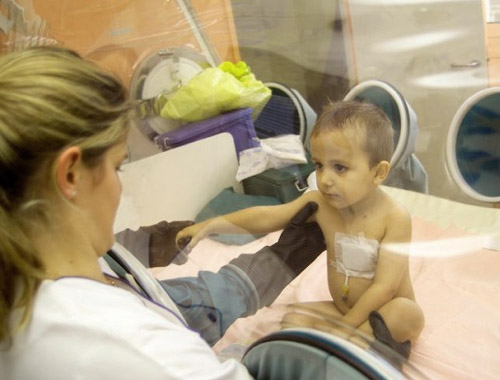Severe combined immunodeficiency

Published: 18 Jun 2025
ICD9: 279.2 ICD10: D81.1 ICD11: 4A01.10
Severe combined immunodeficiency (SCID) is a rare group of life-threatening genetic disorders characterized by a profound deficiency of both T lymphocytes (T cells) and B lymphocytes (B cells), the main infection-fighting cells of the immune system.
This makes individuals with SCID extremely vulnerable to severe, recurrent infections.
Here's a breakdown of what's important to understand about SCID:
![]() Combined Deficiency: The key feature is the lack or malfunction of *both* T cells and B cells. T cells are crucial for cell-mediated immunity, directly attacking infected cells and regulating other immune responses. B cells produce antibodies, which target and neutralize pathogens. Some forms of SCID also affect Natural Killer (NK) cells, further weakening the immune system.
Combined Deficiency: The key feature is the lack or malfunction of *both* T cells and B cells. T cells are crucial for cell-mediated immunity, directly attacking infected cells and regulating other immune responses. B cells produce antibodies, which target and neutralize pathogens. Some forms of SCID also affect Natural Killer (NK) cells, further weakening the immune system.
![]() Severe Consequences: Because the immune system is so severely compromised, even common infections that are harmless to healthy individuals can be fatal to those with SCID. Infants with SCID are often said to live in a "bubble" because they need to be protected from virtually all germs.
Severe Consequences: Because the immune system is so severely compromised, even common infections that are harmless to healthy individuals can be fatal to those with SCID. Infants with SCID are often said to live in a "bubble" because they need to be protected from virtually all germs.
![]() Genetic Basis: SCID is caused by genetic mutations that disrupt the development and function of the immune system. Several different genes can be involved, leading to different subtypes of SCID. Some are X-linked (more common in males), while others are autosomal recessive (affecting both males and females equally).
Genetic Basis: SCID is caused by genetic mutations that disrupt the development and function of the immune system. Several different genes can be involved, leading to different subtypes of SCID. Some are X-linked (more common in males), while others are autosomal recessive (affecting both males and females equally).
![]() Early Onset: Symptoms typically begin in infancy, usually within the first few months of life. Common signs include:
Early Onset: Symptoms typically begin in infancy, usually within the first few months of life. Common signs include:![]()

![]() Failure to thrive (poor weight gain and growth)
Failure to thrive (poor weight gain and growth)![]()

![]() Frequent and severe infections (e.g., pneumonia, meningitis, sepsis)
Frequent and severe infections (e.g., pneumonia, meningitis, sepsis)![]()

![]() Chronic diarrhea
Chronic diarrhea![]()

![]() Skin rashes
Skin rashes![]()

![]() Oral thrush (yeast infection in the mouth)
Oral thrush (yeast infection in the mouth)
![]() Diagnosis: SCID is now often detected through newborn screening programs that test a blood sample for T cell receptor excision circles (TRECs), a marker of T cell production. Further testing is needed to confirm the diagnosis and identify the specific genetic cause.
Diagnosis: SCID is now often detected through newborn screening programs that test a blood sample for T cell receptor excision circles (TRECs), a marker of T cell production. Further testing is needed to confirm the diagnosis and identify the specific genetic cause.
![]() Treatment: The goal of treatment is to restore immune function. The main treatment options include:
Treatment: The goal of treatment is to restore immune function. The main treatment options include:![]()

![]() Hematopoietic Stem Cell Transplantation (HSCT) or Bone Marrow Transplant: This is the most effective treatment and can potentially cure SCID by replacing the defective immune system with a healthy one from a donor.
Hematopoietic Stem Cell Transplantation (HSCT) or Bone Marrow Transplant: This is the most effective treatment and can potentially cure SCID by replacing the defective immune system with a healthy one from a donor.![]()

![]() Gene Therapy: In some forms of SCID, gene therapy can be used to correct the genetic defect in the patient's own stem cells. This is a newer approach but has shown promising results.
Gene Therapy: In some forms of SCID, gene therapy can be used to correct the genetic defect in the patient's own stem cells. This is a newer approach but has shown promising results.![]()

![]() Enzyme Replacement Therapy (ERT): This is used for ADA-SCID (adenosine deaminase deficiency), a specific type of SCID. ERT involves replacing the missing enzyme, but it doesn't fully restore immune function like HSCT or gene therapy.
Enzyme Replacement Therapy (ERT): This is used for ADA-SCID (adenosine deaminase deficiency), a specific type of SCID. ERT involves replacing the missing enzyme, but it doesn't fully restore immune function like HSCT or gene therapy.![]()

![]() Immunoglobulin (Antibody) Replacement Therapy: This provides temporary protection by supplying antibodies to fight infections. It doesn't correct the underlying immune deficiency but can help reduce the frequency and severity of infections. Prophylactic antibiotics and antifungal medications are also often used to prevent infections.
Immunoglobulin (Antibody) Replacement Therapy: This provides temporary protection by supplying antibodies to fight infections. It doesn't correct the underlying immune deficiency but can help reduce the frequency and severity of infections. Prophylactic antibiotics and antifungal medications are also often used to prevent infections.
![]() Prognosis: Without treatment, SCID is usually fatal within the first year or two of life. With early diagnosis and treatment, particularly HSCT or gene therapy, the prognosis is significantly improved, and many children with SCID can live relatively normal lives.
Prognosis: Without treatment, SCID is usually fatal within the first year or two of life. With early diagnosis and treatment, particularly HSCT or gene therapy, the prognosis is significantly improved, and many children with SCID can live relatively normal lives.
In summary, SCID is a serious, life-threatening condition requiring prompt diagnosis and treatment to restore immune function and improve the chances of survival and a healthy life.